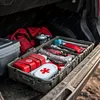
Owning a Subaru Sambar is an exciting experience for car enthusiasts and practical-minded individuals alike. This iconic mini-truck, beloved for its compact size, versatility, and quirky charm, can be an excellent choice for both work and leisure. However, like any vehicle, it requires routine maintenance and occasional repairs to keep running smoothly. To ensure you're always ready to address any issues that may arise, it's crucial to have the right Subaru Sambar parts in your toolbox. These parts will help you manage regular upkeep, make repairs, and enhance your Sambar's performance.
In this article, we’ll explore seven essential Subaru Sambar parts that every car owner should have in their toolbox. Whether you're tackling DIY repairs or just preparing for the unexpected, having these parts on hand will help you avoid delays, reduce repair costs, and ensure your vehicle stays in optimal condition.
1. Air Filters
The air filter is one of the most critical components of any vehicle, and the Subaru Sambar is no exception. It ensures that the engine receives clean air, free from dust and debris, which is vital for optimal engine performance. A clogged or dirty air filter can reduce engine efficiency, increase fuel consumption, and lead to long-term damage if left unchecked.
When performing routine maintenance on your Subaru Sambar, it's essential to have spare air filters in your toolbox. This is an easy part to replace, and it should be done at least once a year or every 12,000 to 15,000 miles, depending on your driving conditions. If you're driving in dusty environments or on rough terrain, you may need to replace it more frequently.
Why You Need It:
Improves engine performance.
Helps maintain fuel efficiency.
Easy to replace and inexpensive.
Tip: Keep a high-quality air filter in your toolbox. Opt for original Subaru Sambar parts to ensure proper fitment and performance.
2. Spark Plugs
Spark plugs play a crucial role in your Subaru Sambar’s engine by igniting the air-fuel mixture to produce power. Over time, spark plugs wear down due to constant exposure to heat, pressure, and chemicals. Worn-out spark plugs can cause misfires, reduced engine performance, and poor fuel economy. If left unchecked, they could cause engine damage and leave you stranded.
Having a spare set of spark plugs in your toolbox ensures that you're prepared for any issues that arise. The Subaru Sambar typically uses smaller engines, so replacing the spark plugs is often more straightforward than on larger vehicles. Make sure to choose the correct spark plugs that match your Sambar’s specifications.
Why You Need It:
Restores engine performance and reliability.
Ensures smooth engine operation.
Easy to replace with basic tools.
Tip: When replacing spark plugs, always check the gap with a spark plug gap tool to ensure it's set to the manufacturer’s recommended setting.
3. Oil and Oil Filters
Regular oil changes are essential for maintaining the health of your Subaru Sambar’s engine. Oil lubricates the engine’s internal components, reducing friction and preventing premature wear. As the oil breaks down over time, it becomes less effective, leading to increased friction and the buildup of harmful contaminants in the engine. To keep things running smoothly, it's crucial to change the oil and replace the oil filter on schedule.
Subaru recommends changing the oil every 3,000 to 5,000 miles or every six months. Having the right oil and oil filter in your toolbox ensures that you can perform an oil change whenever necessary. Be sure to check your owner’s manual for the recommended oil type and filter specifications for your particular Subaru Sambar model.
Why You Need It:
Keeps the engine lubricated and running smoothly.
Reduces the risk of engine damage.
Prevents contaminants from circulating in the engine.
Tip: Choose a high-quality oil filter that matches the specifications of your Subaru Sambar to ensure effective filtration and protect your engine.
4. Brake Pads
Your Subaru Sambar’s braking system is one of the most important safety features, and it requires regular attention to ensure that it functions properly. Brake pads wear out over time due to friction with the brake discs, and they need to be replaced periodically. Worn brake pads can reduce braking performance, leading to increased stopping distances and potential safety hazards.
Having spare brake pads in your toolbox allows you to replace them as needed, keeping your Subaru Sambar's braking system in top condition. Depending on your driving habits, you may need to replace the brake pads every 25,000 to 50,000 miles. If you hear squealing or grinding noises when braking, it’s time to inspect the brake pads and consider replacing them.
Why You Need It:
Ensures reliable braking performance.
Enhances vehicle safety.
Easy to replace with basic tools and knowledge.
Tip: If you’re performing brake pad replacement yourself, make sure to also inspect the brake rotors for signs of damage or wear. If needed, have them resurfaced or replaced for optimal braking performance.
5. Belts and Hoses
The belts and hoses in your Subaru Sambar are responsible for driving various engine components, such as the alternator, water pump, and air conditioning compressor. Over time, belts can crack, fray, or stretch, while hoses may become brittle or leak. A failure of any of these components can lead to engine overheating, loss of power, or other serious issues.
To prevent unexpected breakdowns, it’s wise to keep a few spare belts and hoses in your toolbox. When inspecting your Subaru Sambar, check the condition of these parts regularly and replace them at the first sign of wear. Pay particular attention to the timing belt, serpentine belt, and radiator hoses.
Why You Need It:
Helps prevent engine overheating and other mechanical failures.
Can be a lifesaver in an emergency situation.
Prevents costly repairs by addressing issues early.
Tip: Always replace belts and hoses according to your vehicle's recommended maintenance schedule. This can save you from unexpected breakdowns, especially during long trips.
6. Fuses
Fuses are small but crucial components that protect the electrical system in your Subaru Sambar. They prevent electrical circuits from overloading, which could otherwise cause damage to vital components such as the alternator, headlights, or radio. If any of the electrical components in your vehicle stop working, it could be due to a blown fuse.
Having a variety of spare fuses in your toolbox is a simple yet effective way to prepare for electrical failures. Subaru Sambars typically use blade-type fuses, which are easy to replace. Keep a selection of different amperage fuses on hand to cover various systems in your vehicle.
Why You Need It:
Protects electrical components from overloading.
Helps restore electrical function quickly.
Easy to replace with minimal tools.
Tip: Keep a fuse puller tool in your toolbox to make the replacement process even easier.
7. Tire Repair Kit
A flat tire is one of the most common issues that car owners face, and being prepared can save you a lot of time and frustration. A tire repair kit is an essential tool for any Subaru Sambar owner. These kits typically contain a variety of tools, including plugs, patches, a reamer tool, and a tire inflator. With these items, you can quickly repair small punctures and get back on the road until you're able to replace the tire.
While a spare tire is always a good idea, tire repair kits are compact and lightweight, making them easy to store in your Subaru Sambar. If you find yourself in a pinch, you’ll be glad to have a repair kit on hand.
Why You Need It:
Enables quick repairs for minor tire damage.
Saves time and money compared to a tow or tire replacement.
Portable and convenient to store.
Tip: Always check the tire repair kit for expired or damaged items before heading out on a long trip.
Conclusion
Maintaining a Subaru Sambar requires having the right Subaru Sambar parts in your toolbox to keep your vehicle running smoothly. The seven parts we've highlighted—air filters, spark plugs, oil and oil filters, brake pads, belts and hoses, fuses, and tire repair kits—are all essential for routine maintenance and repairs. By keeping these parts on hand, you’ll be prepared for minor issues and able to perform DIY repairs with ease.
Regular maintenance and timely repairs can prolong the life of your Subaru Sambar and help you avoid costly repairs down the road. Whether you’re an experienced mechanic or a novice car owner, these essential parts will ensure that you can handle most common issues with confidence. Keep your Subaru Sambar in top shape by stocking these parts in your toolbox and stay ready for whatever the road throws your way.













